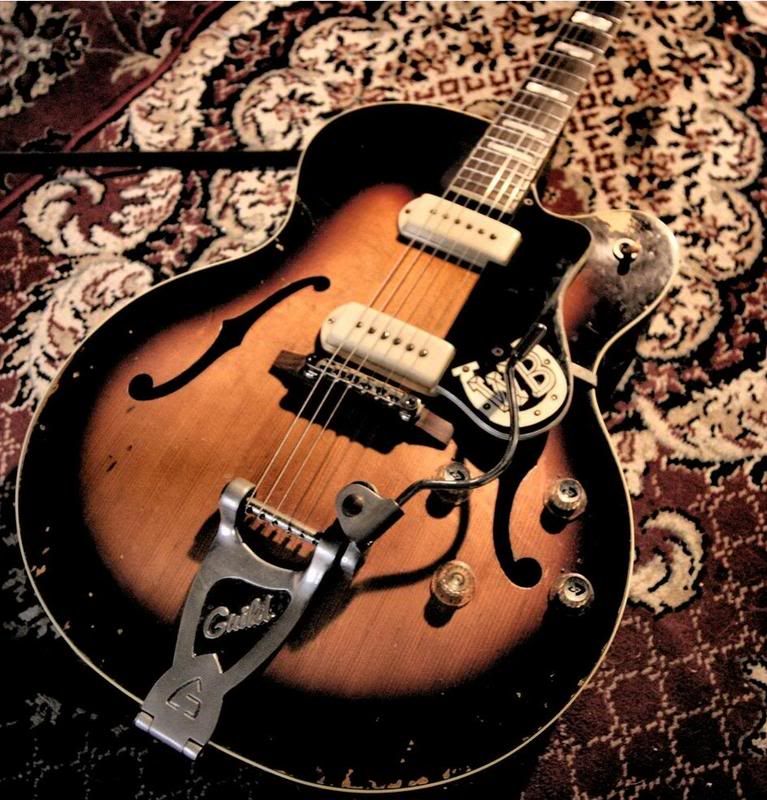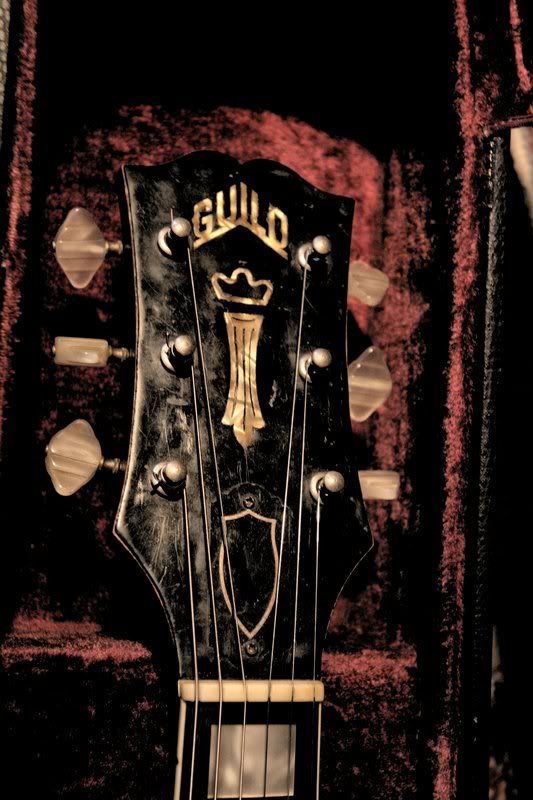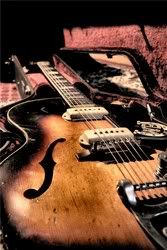You are using an out of date browser. It may not display this or other websites correctly.
You should upgrade or use an alternative browser.
You should upgrade or use an alternative browser.
Showing off amateur photography skills
- Thread starter Guilderagain
- Start date
- Joined
- Jul 30, 2007
- Messages
- 13,654
- Reaction score
- 3,084
- Location
- Philly, or thereabouts
- Guild Total
- 11
Default said:
I love it! :lol: :lol: :lol:
Alex,
Nice guitar, and nice photo. I had thought about starting a thread here on photographic techniques for guitars, but didn't know if there would be any interest. At least there are two of us! Guitars, especially arch tops are one of the most difficult objects to photograph well IMHO. The complex and compound contours, along with a highly reflective finish is a nightmare to deal with. As I'm sure you know, in photography, lighting is almost everything. I have concluded that it takes at least 3 good and highly diffused light sources to get a decent photo of a guitar (more than 3 would be even better). I am shopping for more strobes and looking into building up a couple soft boxes or panel diffusers too. I have tried using shoot through umbrellas, but on close examination, was dismayed to find that in a highly polished finish, you could actually see the "spider wires" of the umbrella in the light source reflection!!! It almost looked like cracks in the guitar's finish. Definitely not a good thing.
That's a nice backdrop you have. Works well with a guitar that is fully bound, including the headstock. I'd be interested in hearing the full details of your set up for this shot. Obviously, your primary light source was off camera to the right. Did you try bracketing the aperture? It's hard to tell how accurate the reproduction is after the original has probably been reduced in size and resolution and who knows how good the color rendition of different monitors is, but it appears to be just slightly over exposed (this is an observation, NOT a criticism). My blonde X500T is quite a bit darker in color, but that could just be the guitar of course. I have found that a big dark background like that can cause problems with some metering modes when the foreground object is light - using full manual or else a spot metering mode is helpful.
I'd be glad to share ideas on this subject. Hopefully there are a few other camera buffs out there too that can chime in with some magic bullets for getting good shots like this.
Best regards,
Tom Moll
Nice guitar, and nice photo. I had thought about starting a thread here on photographic techniques for guitars, but didn't know if there would be any interest. At least there are two of us! Guitars, especially arch tops are one of the most difficult objects to photograph well IMHO. The complex and compound contours, along with a highly reflective finish is a nightmare to deal with. As I'm sure you know, in photography, lighting is almost everything. I have concluded that it takes at least 3 good and highly diffused light sources to get a decent photo of a guitar (more than 3 would be even better). I am shopping for more strobes and looking into building up a couple soft boxes or panel diffusers too. I have tried using shoot through umbrellas, but on close examination, was dismayed to find that in a highly polished finish, you could actually see the "spider wires" of the umbrella in the light source reflection!!! It almost looked like cracks in the guitar's finish. Definitely not a good thing.
That's a nice backdrop you have. Works well with a guitar that is fully bound, including the headstock. I'd be interested in hearing the full details of your set up for this shot. Obviously, your primary light source was off camera to the right. Did you try bracketing the aperture? It's hard to tell how accurate the reproduction is after the original has probably been reduced in size and resolution and who knows how good the color rendition of different monitors is, but it appears to be just slightly over exposed (this is an observation, NOT a criticism). My blonde X500T is quite a bit darker in color, but that could just be the guitar of course. I have found that a big dark background like that can cause problems with some metering modes when the foreground object is light - using full manual or else a spot metering mode is helpful.
I'd be glad to share ideas on this subject. Hopefully there are a few other camera buffs out there too that can chime in with some magic bullets for getting good shots like this.
Best regards,
Tom Moll
cc_mac
Member
Whoa, nice pic! Now on my desktop 
john_kidder
Senior Member
I look forward to this discussion (as a reader, not a contributor). My guitar photos are pretty plain and utilitarian, not at all artistic. Hope to get some tips, even for a rank amateur.
I'm sure Hans will have lots to add here as well. The photos in The Guild Guitar Book are the best and certainly the most consistent I've seen so far.
I have a feeling there's an earlier thread on this subject here - I'll see if I can track it down.
And that is a beautiful picture of a beautiful guitar.
I'm sure Hans will have lots to add here as well. The photos in The Guild Guitar Book are the best and certainly the most consistent I've seen so far.
I have a feeling there's an earlier thread on this subject here - I'll see if I can track it down.
And that is a beautiful picture of a beautiful guitar.
john_kidder
Senior Member
Here's one thread - viewtopic.php?f=2&t=6881&p=70847&hilit=exposure#p70847
Walter Broes
Enlightened Member
Nice pic, nice guitar! I suck so hard at taking pictures it's ridiculous.
A proper photographer took pics of my beloved '62 Manhattan once for a book he's (still) working on about Belgian guitarists and their favorite instrument, and I liked what he did - they're "artsier", not the beautiful daylight "full monty" shots that are in Hans' book. (which I love too)
Here's a couple this guy took :



A proper photographer took pics of my beloved '62 Manhattan once for a book he's (still) working on about Belgian guitarists and their favorite instrument, and I liked what he did - they're "artsier", not the beautiful daylight "full monty" shots that are in Hans' book. (which I love too)
Here's a couple this guy took :



Here's an excellent tip I learned from drednut:tmoll said:... That's a nice backdrop you have. Works well with a guitar that is fully bound, including the headstock. I'd be interested in hearing the full details of your set up for this shot. ...
Best regards,
Tom Moll
If you use bedsheets as a backdrop, be sure to iron them.
Guilderagain
Member
tmoll said:Alex,
"Nice guitar, and nice photo ... I'd be interested in hearing the full details of your set up for this shot."
Best regards,
Tom Moll
Hello Tom,
Thanks for the compliment. Perhaps my skills are better at composition than technical abilities.
In the early 80's I was very enthusiastic about photography. I took a course in college and started to take black and white photographs along with priniting them as well. It was very enjoyable - particularly priniting. I had an Olympus OM10. I even contemplated investing in an 8' x 10" studio camera to take up studio work. Alas, the years rushed by and all I have left is some weak technical recollections of what I had done. Though I still have a critical eye. All to often I see poor images of guitars (not at LTG of course!) This is true especially in E bay. All to often you see the usual out of focus and or poor lighting coupled with backgrounds that turn the eye away from the subject.
To answer your question, first, let me just say that your knowledge of photography and technical skills far exceed mine! However, let's start with the equipment. Don't laugh, but it's a Nikon Coolpix 3100 (with 3 lowly megapixels). Since this is a generic digital camera with generic manual adjustments, I cannot interpret the adjustments as in a traditional camera, but I'll try based on it's specifications.
Lens: I had it at wide - 5.8 mm
Image: 2048 x 1536 (1:4)
Exposure Compensation: -.7 ( not sure what that means, no shutter speed on this :lol: )
Flash: No
F stop: ? note sure The camera is ranged from 2.8 - 4.9 It was set on macro, so I'm guessing 2.8
Yes, I agree, the shot is a bit over exposed. Of the twelve I took, this was, in my opinion, the nicest. The lighting was partial diffused (ahem, would you believe a lamp?) and outside light from the window (the primary light source to the right). The background was a hung maroon poly fiber blanket with similair material for the base.
Thanks for your interest and I agree that this would be an interesting thread. I'll be taking some shots of my X-170 and X-150 next.
Best Regards,
Alex Robatto
Alex,
Thanks for the info. There could be many analogies drawn between guitars and photography. I too used to be into photography in a big way, but it was way back in the '70's and '80's. Around 2000 I bought a (then) state of the art 2 megapixel Olympus digital camera. It served me well until just a month or so ago I decided to get serious again and bought a Nikon D90. An inexpensive digital is capable of taking very good pictures in the hands of someone with a good eye for composition, just like a good musician can take a piece of junk guitar and make beautiful music on it. Using more expensive equipment (camera or guitar) makes the job easier, but does NOT guarantee better results! High megapixel cameras don't provide much benefit when the image is compressed down to a little JPEG for Internet viewing. It's the same as using an expensive ProTools setup for high sampling rate recording and then squashing it down to an MP3. In photography, the digital darkroom with tools like PhotoShop have taken over, and are the equivalent to ProTools in the music world. Then end result may not remotely resemble the original input. This can be good, or it can be bad. There is art in the original work, and there is art in the processing of the original work. They are closely related, but are two different things. In photography, just like in recording music, there is the concept of high dynamic range (HDR). In photography, this is usually accomplished by taking multiple shots of the same image at different exposures, and then combining them digitally in a way that provides the desired levels of exposure for all areas of the image. This would allow great definition of the grain in a light blonde guitar top, as well as equal definition of the grain in a dark ebony fingerboard in the same image. the resulting images can be stunning, but sometimes they look "fake". This is extraordinarily difficult to accomplish with a single exposure.
I would love to hear some tips from the photographer(s) that contributed to Hans' book - I agree they are superb!!!
Tom Moll
Thanks for the info. There could be many analogies drawn between guitars and photography. I too used to be into photography in a big way, but it was way back in the '70's and '80's. Around 2000 I bought a (then) state of the art 2 megapixel Olympus digital camera. It served me well until just a month or so ago I decided to get serious again and bought a Nikon D90. An inexpensive digital is capable of taking very good pictures in the hands of someone with a good eye for composition, just like a good musician can take a piece of junk guitar and make beautiful music on it. Using more expensive equipment (camera or guitar) makes the job easier, but does NOT guarantee better results! High megapixel cameras don't provide much benefit when the image is compressed down to a little JPEG for Internet viewing. It's the same as using an expensive ProTools setup for high sampling rate recording and then squashing it down to an MP3. In photography, the digital darkroom with tools like PhotoShop have taken over, and are the equivalent to ProTools in the music world. Then end result may not remotely resemble the original input. This can be good, or it can be bad. There is art in the original work, and there is art in the processing of the original work. They are closely related, but are two different things. In photography, just like in recording music, there is the concept of high dynamic range (HDR). In photography, this is usually accomplished by taking multiple shots of the same image at different exposures, and then combining them digitally in a way that provides the desired levels of exposure for all areas of the image. This would allow great definition of the grain in a light blonde guitar top, as well as equal definition of the grain in a dark ebony fingerboard in the same image. the resulting images can be stunning, but sometimes they look "fake". This is extraordinarily difficult to accomplish with a single exposure.
I would love to hear some tips from the photographer(s) that contributed to Hans' book - I agree they are superb!!!
Tom Moll

